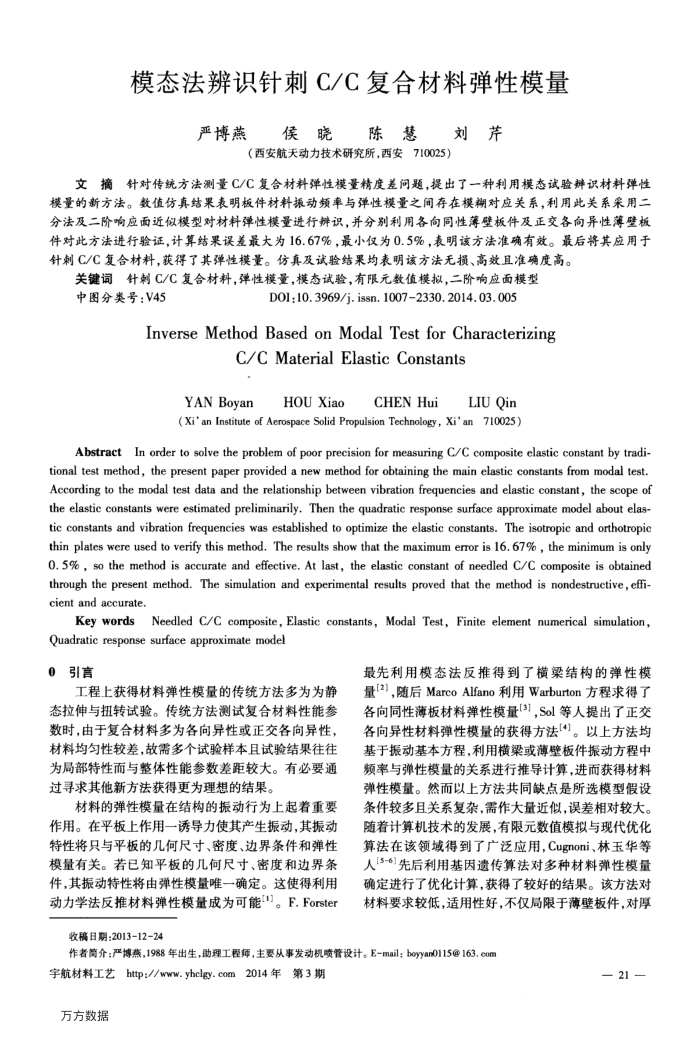您当前的位置:首页>论文资料>模态法辨识针刺C∕C复合材料弹性模量
内容简介
 模态法辨识针刺C/C复合材料弹性模量
模态法辨识针刺C/C复合材料弹性模量严博燕侯晓陈慧刘芹
(西安航天动力技术研究所,西安710025)
文摘针对传统方法测量C/C复合材料弹性模量精度差问题,提出了一种利用模态试验辨识材料弹性模量的新方法。数值仿真结果表明板件材料振动频率与弹性模量之间存在模糊对应关系,利用此关系采用二分法及二阶响应面近似模型对材料弹性模量进行辨识,并分别利用各向同性薄壁板件及正交各向异性薄壁板件对此方法进行验证,计算结果误差最大为16.67%,最小仅为0.5%,表明该方法准确有效。最后将其应用于针刺C/C复合材料,获得了其弹性模量。仿真及试验结果均表明该方法无损、高效且准确度高。
关键词针刺C/C复合材料,弹性模量,模态试验,有限元数值模拟,二阶响应面模型
中图分类号:V45
DOI:10.3969/j.issn.10072330.2014.03.005
Inverse Method Based on Modal Test for Characterizing
C/CMaterialElasticConstants
YANBoyan
HOUXiao
CHEN Hui
LIUQin
( Xi' an Institute of Aerospace Solid Propulsion Technology, Xi' an710025)
AbstractIn order to solve the problem of poor precision for measuring C/C composite elastic constant by tradi-tional test method, the present paper provided a new method for obtaining the main elastic constants from modal test. According to the modal test data and the relationship between vibration frequencies and elastic constant, the scope of the elastic constants were estimated preliminarily. Then the quadratic response surface approximate model about elas-tic constants and vibration frequencies was established to optimize the elastic constants. The isotropic and orthotropic thin plates were used to verify this method. The results show that the maximum error is 16.67% , the minimum is only 0. 5% , so the method is accurate and effective. At last, the elastic constant of needled C/C composite is obtained through the present method. The simulation and experimental results proved that the method is nondestructive, effi cientand accurate.
Key wordsNeedled C/C composite,Elastic constants, Modal Test,Finite element numerical simulation, Quadratic response surface approximate model
0
引言
工程上获得材料弹性模量的传统方法多为为静态拉伸与扭转试验。传统方法测试复合材料性能参数时,由于复合材料多为各向异性或正交各向异性,材料均匀性较差,故需多个试验样本且试验结果往往为局部特性而与整体性能参数差距较大。有必要通过寻求其他新方法获得更为理想的结果。
材料的弹性模量在结构的振动行为上起着重要作用。在平板上作用一诱导力使其产生振动,其振动特性将只与平板的几何尺寸、密度、边界条件和弹性模量有关。若已知平板的几何尺寸、密度和边界条件,其振动特性将由弹性模量唯一确定。这使得利用动力学法反推材料弹性模量成为可能。F.Forster
收稿日期:2013-12-24
最先利用模态法反推得到了横梁结构的弹性模量[2],随后MarcoAlfano利用Warburton方程求得了各向同性薄板材料弹性模量[3],Sol等人提出了正交各向异性材料弹性模量的获得方法[4]。以上方法均基于振动基本方程,利用横梁或薄壁板件振动方程中频率与弹性模量的关系进行推导计算,进而获得材料弹性模量。然而以上方法共同缺点是所选模型假设条件较多且关系复杂,需作大量近似,误差相对较大。随着计算机技术的发展,有限元数值模拟与现代优化算法在该领域得到了广泛应用,Cugnoni、林玉华等人[5-6]先后利用基因遗传算法对多种材料弹性模量确定进行了优化计算,获得了较好的结果。该方法对材料要求较低,适用性好,不仅局限于薄壁板件,对厚
作者简介:严博燕,1988年出生,助理工程师,主要从事发动机喷管设计。E-mail;boyan0115@163.eom
宇航材料工艺http://www.yhclgy-com2014年第3期万方数据
- 21
上一章:压印接头典型失效形式及机理
下一章:适用于长时间烧蚀防热的蜂窝增强低密度材料